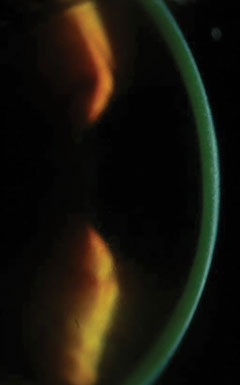 |
| PiXL may reduce low-grade myopia in eyes with no adverse events. |
Photorefractive intrastromal crosslinking (PiXL) is a refractive procedure that reshapes the corneal stroma without the need for epithelial debridement or stromal removal. A recent study, based in Sweden, assessed epi-on PiXL in high oxygen for low myopia by comparing the treatment effects, safety outcomes and subjective ocular discomfort of two different treatment zone designs, sizes and light pulse intervals with a follow-up of 24 months. The researchers noted that the 3.5mm treatment zone protocol superseded that of the 4.0mm protocol, with slightly better visual and refractive outcomes through the follow-up period and less ocular discomfort earlier on.
The study treated 27 individuals (54 eyes) between the ages of 19 and 35 with bilateral low-grade myopia (manifest refractive spherical equivalent: -0.75D to -2.50D). One eye was randomized to receive pulsed accelerated 365nm ultraviolet-A illumination in a central annular zone of 4.0mm (one second on, one second off at 30mW/cm2), and the fellow eye in a 3.5mm annular zone (0.5 seconds on, one second off at 45mW/cm2).
After six months, participants perceived the 3.5mm treatment to give a better subjective vision than the 4.0mm treatment. No difference was reported at any other time point. The 3.5mm treatment gave less subjective ocular discomfort at one-day post-op. At visits after one week, no patient reported any ocular discomfort, except one patient with the 3.5mm at three months and one with the 4.0mm at 12 months post-op.
The researchers noted a significant improvement in uncorrected distance visual acuity was seen at one-month follow-up, with a larger improvement for the 3.5mm compared with the 4.0 mm protocol (-0.52 logMAR and -0.38 logMAR, respectively). The treatment effect remained stable over time in both groups.
However, low-contrast visual acuity reduction lasted longer in the 3.5mm treatment zone group. Both treatments showed an initial reduction at one month for low-contrast visual acuity at 10%, with a larger impairment with the 3.5mm protocol than the 4.0mm (+0.16 logMAR and +0.12 logMAR, respectively). For low-contrast visual acuity at 2.5%, there were reductions with the 3.5mm protocol up to 12 months post-op (+0.42 logMAR at one month) compared with the 4.0mm protocol where reductions were seen at the one-month (+0.12 logMAR, although not statistically significant) and three-month post-op (+0.14 logMAR). Nevertheless, both 10% and 2.5% low-contrast visual acuity reverted and no statistically significant reductions were seen at 24 months compared with baseline in either treatment protocol.
“A more plausible explanation for the deterioration in low-contrast visual acuity is that it owes to a combination of an initial increase in post-treatment central haze and spherical aberrations, the latter potentially being more pronounced with a smaller treatment protocol,” the researchers noted.
Regardless, they concluded PiXL appears to be an efficient treatment to improve uncorrected vision and reduce low-grade myopia in healthy eyes without any adverse events.
Näslund S, Beckman Rehnman J, Fredriksson AN, Behndig A. Comparison of two annular photorefractive intrastromal cross-linking protocols in high oxygen for low-grade myopia through 24-month follow-up. Acta Ophthalmol. October 5, 2021. [Epub ahead of print]. |

